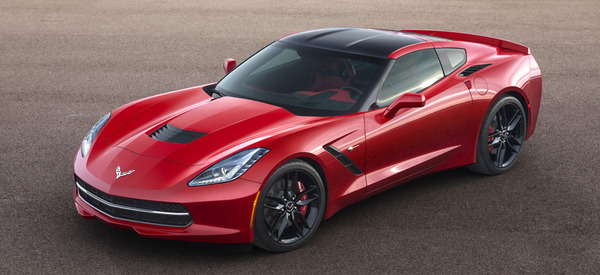
2014 Chevrolet Corvette Stingray
2014 Chevrolet Corvette Stingray Review
Fast as it ever was.
Web2Carz Contributing Writer
Published: August 21st, 2013
During our tour of Steinbeck country in Chevrolet's seventh-generation Corvette, now dubbed the Corvette Stingray, we had our fair share of admirers. Perhaps most conspicuous was the teenager who turned fully around in the passenger seat of his parent's sedan as it passed us on the 101 (we were in sedate cruise mode), but our keen observational skills noticed that it wasn't humans who were the most interested in the cars: it was the local fauna.
Several suicidal squirrels (we lost count) nearly met their fates under the wheels of our Torch Red tester. Not only did the Rocky J. Squirrel wannabes survive, but so did two deer who decided to get a closer look - a young Bambi that wisely decided life on the side of the road would last longer, and a full-grown deer that felt that getting a good view wasn't enough - the 'Vette's brakes needed testing, too.
Fortunately for all parties involved, no animals or sports cars were harmed. We can't blame the aimless animals for their attraction to the 'Vette: it's fully redesigned, it looks great (the angular interpretation of the Corvette formula looks better in person than pictures), and it has an exhaust note from heaven, especially in the right drive mode. It's been hyped heavily since its unveil at the 2013 North American International Auto Show in Detroit last January, and after sampling it somewhere near Monterey, we can say it's got the goods.
There's a lot new besides the looks (inside and out). For starters, there's the new LT1 V-8 underhood, pumping out 460 ponies and 465 lb-ft of torque. Should you choose to shift yourself (and really, you should), you get a seven-speed manual with a rev-matching system. The hood and roof panel are carbon fiber. There's a drive-mode selector. Also among the highlights of the new is the customizable driver's info screen, which changes modes depending on what drive mode you've selected, and offers further customization, as well.
An electronic limited-slip differential that comes as part of the Z51 performance package (right now, every car is considered to be either "base" or Z51 in performance terms, but that's misleading when parsing other available features, since there are three options groups: 1LT, 2LT, and 3LT. Someone at Chevy needs to learn clarity.) uses an algorithm to manage the torque split between the rear wheels. One of the benefits of this system is improved traction while exiting a corner, according to Chevy.
Ticking zed-five-one on the options box will also get you cooling systems for the transmission, differential, and brakes; a dry-sump oil system, special Michelin rubber, upgraded brakes, and an aerodynamics system.
Other new stuff includes carbon-nano composite under-body panels, LED headlights, and two new types of seats (we'll get to them later).
We've kept you waiting long enough. What's it like to drive the damn thing?
-
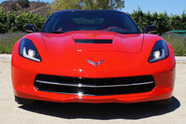
On the Road
The outgoing 'Vette was a rocket that generally handled well, but could get scary at the limit and bite you in the ass should you over do it. The new 'Vette is a rocket that handles as well or better than the outgoing car and doesn't feel as temperamental, provided all electronic aids are left on.
Differing drive modes aren't a new idea for the Corvette, but the drive selector on the new model is easily accessible - no need to dig through menus when you can just flick a knob right and left. The modes are Weather, Eco, Touring (default), Sport, and Track. The names are fairly self-explanatory, and given that our drive was limited to public roads, we spent most of our time in Touring and Sport, with brief dabbles in Eco during highway cruising. Changing the mode changes a dozen different attributes. Steering feel, gauge configuration, exhaust note, fuel management, electronic throttle control, the electronic limited-slip (Z51), automatic-transmission shift points, launch control, magnetic ride control, stability control, traction control, and Track-mode-only Performance Traction Management system (adjusts torque and braking settings for on-track driving) are all affected by the various modes.
Some notes: cylinder deactivation, which turns the V-8 into a four-cylinder at light throttle and speeds up to 90 mph, is available in Eco mode, while launch control and Performance Traction Management only show up in Track, along with a competition mode for the stability control, which can also be manually switched off separately. Traction control, which also can be turned off with a button tap, is optimized to keep the car on-road during rain or snow in Weather mode.
As detailed further below, the gauge cluster and head-up display also adjust based on mode.
Tour is the default for a reason: it allows for a mix of comfort and sport and easy daily driving. This is the putt-putt mode, if a beast like this with a snorty exhaust growl can ever be described using the term "putt-putt." This is the mode you want to be in when cruising to dinner before going to the drive-in, or when commuting to the golf course (unless bad weather threatens, of course. Or unless your gas budget is tight, in which case Eco is where you want to be.). The car sounds great, the steering finds a nice balance between tight and light, and acceleration is still ungodly fast (GM is claiming 3.8 seconds for 0-60 mph and the quarter-mile in 12 seconds flat at 119 mph). This is all well and good, until the canyon road beckons. One flick to the right, and Sport mode brings to the party noticeably tauter steering and a basso profundo exhaust note that borders on sexual. Not to mention a gauge cluster display that is far more helpful for spirited driving, especially in the head-up display.
We engaged Sport mode for most of our drive, and not just because the car seemed to hug corners slightly tighter - we couldn't get enough of that exhaust. But hearing is just one sense of five, so we got the rest involved by hammering the car hard through California's tight corners. We admit to being conservative at first - the 'Vette is a wide car with lots of power, and no journalist wants to end up on YouTube (and every blog) for the wrong reasons. But as we learned the car (and the road), confidence grew quickly. One colleague astutely noted that the car drives smaller than it is, and we concur. It's smooth and sublime, with little body roll. Come in too wide, and a quick adjustment to the steering is matched with a flat tuck in the preferred direction. Switching from Tour to Sport eliminates some slight play in the steering off-center (it's not much to begin with) but the steering never gets too heavy. It's easy to hustle fast, at speeds that will cause your passenger to reconsider riding with you while contemplating a sudden need for fresh underwear.
Chevy intentionally turned us loose on some rough roads that would be at home in Detroit, and the Corvette, while riding rather stiffly, never seemed too upset. Annoyed, maybe, but not to the point of lost composure.
The combination of bumpy roads and sticky sports-car tires meant lots of tire noise leaking into the cockpit (to be fair, the radio was off, the exhaust was music enough) but wind noise was kept to a minimum.
If this was a fifth-grade essay outline and we needed to sum up ride and handling in a sentence or two, we'd call it a fitting compromise between around-town comfort and spirited back-road driving. Without track time, we can't judge its on-track abilities fairly, but our sampling bodes well - the 'Vette will hang with 911s, Vipers, GT-Rs, and any other cars of that ilk it might encounter on track day.
With all this talk about what happens in the corners, it feels like we're forgetting something. Hmmm ... oh, right, acceleration and braking. There's only so many ways to say "holy crap, that's fast," but we'll just go with "#!@%%!" Sixty mph occurs in a blink and triple digits show up faster than you can say "Is there a problem, officer?" Empty, flat roads in the middle of nowhere become impromptu drag strips. Corner-to-corner leaps are amazingly quick, and the brakes are reassuring when you need them - and given the handling chops, you won't need as much of them as you'd think. The car can do more than you can.
The seven-speed manual surprised us - the clutch and shifter were light and crisp (although we'd like some more heft and mechanical feelings from the shifter, but clutch take-up was fine) and easy to use at low speeds. Our only complaint was a fifth gate that was hard to find - we shifted from fourth to seventh accidentally once or twice. Then again, with so much torque, what gear you're in may not matter - we often stayed in fourth to leave corners where we'd normally downshift to third.
Fuel economy is of almost no concern to sports-car buyers, but we saw around 17 mpg in the automatic-transmission car and averages in the 14-16 mpg range in the manual, even with heavy driving. Chevy is claiming up to 30 mpg highway in Eco mode with the manual transmission. -
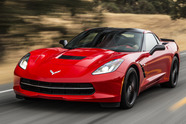
Exterior
We'll admit, our "oohs" and "ahhs" were muted when the cover came off in Detroit. We liked it, maybe even a lot, but we weren't instantly sold. Up close, though, the car looked great, with certain colors sparkling more than others. It's especially intimidating in the rearview mirror.
The roof panel is removable, but should you choose to do so, you'll eliminate most of the usable cargo space - which ain't much to begin with - in the rear hatch. Those vents behind the doors on the Z51? Yeah, they're functional, getting air for cooling to the rear differential and transmission. Front fender vents help reduce drag by cutting underhood air pressure. The hood vents reduce lift. Exterior door handles are hidden for clean looks and clean airflow.
It's a looker. We just wish the deer would keep a respectful distance next time. Brake tests are only fun when planned. -

Interior
The cabin in the outgoing Corvette was, oh how shall we say, much derided? Roundly panned? Held a special place in auto-journalist hell? That may be exaggerating, but thanks to seats that redefined uncomfortable, a hodgepodge of hard plastics, and design decisions that baffled the sane mind, the old cockpit felt outdated and cheesy. Not so with the new.
Design-wise, it's not mind-blowing. It's not as artfully graceful as that of the 911 or as filled with techno-geekery as that of the GT-R, but it works. It's functional, which is a huge step up. Just about everything is where it should be, everything is easy to read, and it doesn't take advanced degrees to figure out the infotainment system. There are two USB ports and an auxiliary port tucked away in the tiny center console, and a third USB port hidden behind the hide-and-seek nav screen. That disappearing screen also hides a storage cubby.
The configurable screen offers an overwhelming array of options. The basic screen is dependent on drive mode - Tour shows trip info, switching to Sport shows a digital tachometer among other performance data, and the centerpiece of Track mode is a tach that comes straight from the race car. Other info available includes audio, navigation, trip, and performance gauges that can be used to measure acceleration times or g-forces, to name two examples.
Much has been made about the new seats, and they are quite good. The bolstering may be too much for around-town trundling, but it's perfect for back-road blasts, and we never felt tired, even after an 80-minute stint. Headroom and legroom are more than acceptable, and entry and exit is surprisingly easy for a low-slung sportster. Overall, the cabin felt larger than it is.
There are flaws - there's still a bit too much hard plastic (GM tries to cover it with leather in some places) for a car of this price point, and the body-colored interior trim will be pleasing to some and an eyesore to others. Some of the switchgear still looks a bit gimmicky (the overall design follows themes seen in the Silverado full-size truck). But no more will the interior be the cause of complaint. There are better cabins in this class, but what's inside the doors is finally on par. -
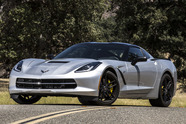
Final Thoughts
For years, the Corvette did straight-line speed well while also offering solid handling that could turn scary far too quickly. It was always considered a performance bargain, but one that came with sacrifices, mainly in cabin quality. It was a brute among more civilized options, the brash American at a bar full of snooty tourists. Only one other car, the Viper, was more uncouth. Now that both the 'Vette and Viper are redesigned, the 'Vette exudes a blend of civility and raw edginess, while the (albeit slightly defanged) Viper remains rough around the edges, at a higher price.
Perhaps a 911 or GT-R might handle better or offer a bit more luxury, but not at this price point. Which is where the Corvette succeeds. It's a near-perfect blend of urban charm and barroom brawler. It's not just a track car that you can take to dinner at the country club - it's a sports car that can commute effortlessly. Drive it like a Cruze if you wish, and you'll be piloting one good-looking sports tourer. That would be a shame, though. Comfortable as it may be around town, the Corvette is meant to be driven hard.
Boiled down to its essence, the seventh-generation Corvette improves on what the previous car did well, fixes what it didn't (and how), and remains a relative performance bargain in the process.
Perhaps Corvette aficionados would like some venison in celebration. -
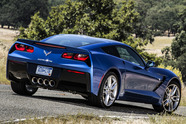
Specs, Features, and Prices
Engine: 6.2-liter V-8
Horsepower: 460
Torque: 465
Transmission: Seven-speed manual or six-speed automatic
Drive Wheels: Rear-wheel-drive
Fuel Economy: 17 mpg city/29 mpg highway w/manual, TBD w/automatic
Base Price: $51,995 (including $995 destination fee)
Available Features: Bluetooth, USB, navigation, satellite radio, Z51 Performance Package (electronic limited-slip differential, cooling systems for the transmission, differential, and brakes; dry-sump oil system, Michelin performance tires, upgraded brakes, and an aerodynamics system), drive-mode selector, upgraded seats, carbon-fiber interior accents, leather interior accents, head-up display, customizable gauge cluster.
• For more information such as specs, prices, and photos of the 2014 Chevrolet Corvette, click here: 2014 Chevrolet Corvette.














